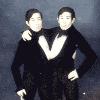Chang & Eng Bunker (1835 or 1836) - public domain Tags: Conjoined Twins View |
Topics: Health Tags: Conjoined Twins View |
Conjoined twins (also known as Siamese twins) are mlTwinIdentical_twinsidentical twins whose bodies are joined in utero. A rare phenomenon, the occurrence is estimated to range from 1 in 50,000 births to 1 in 100,000 births, with a somewhat higher incidence in Southwest Asia and Africa. Approximately half are stillborn (stillbirth), and a smaller fraction of pairs born alive have abnormalities incompatible with life. The overall survival rate for conjoined twins is approximately 25%. The condition is more frequently found among females, with a ratio of 3:1.
Two contradicting theories exist to explain the origins of conjoined twins. The older and most generally accepted theory is fission, in which the fertilized egg splits partially. The second theory is fusion, in which a fertilized egg completely separates, but stem cells (which search for similar cells) find like-stem cells on the other twin and fuse the twins together. Conjoined twins share a single common chorion, placenta, and amniotic sac, although these characteristics are not exclusive to conjoined twins as there are some monozygotic but non-conjoined twins that also share these structures in utero.
The most famous pair of conjoined twins was Chang and Eng Bunker (Thai: ???-???, In-Chan) (1811–1874), Thai (Thailand) brothers born in Siam, now Thailand. They traveled with P.T. Barnums circus for many years and were billed as the Siamese Twins. Chang and Eng were joined by a band of flesh, cartilage, and their fused livers at the torso. In modern times, they could have been easily separated. Due to the brothers fame and the rarity of the condition, the term came to be used as a synonym for conjoined twins.
Diseasesdb: 34474
Icd10: ICD10O337o30, ICD10Q894q80
Icd9: ICD9678.1, ICD9759.4
Emedicinesubj: ped
Emedicinetopic: 2936
Meshid: D014428




